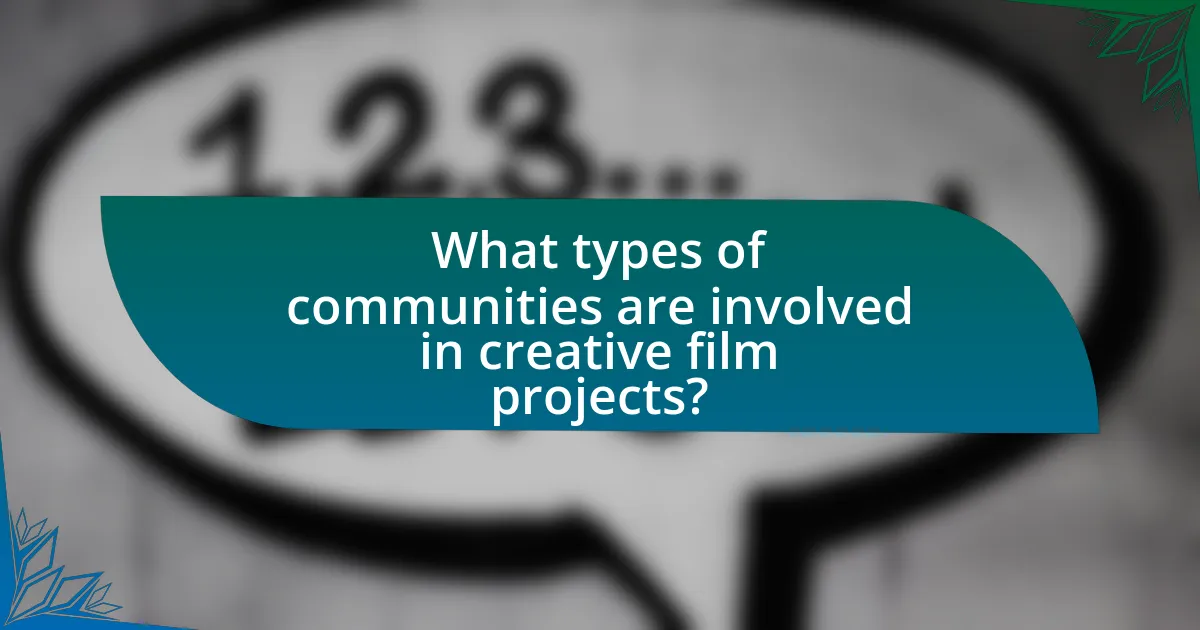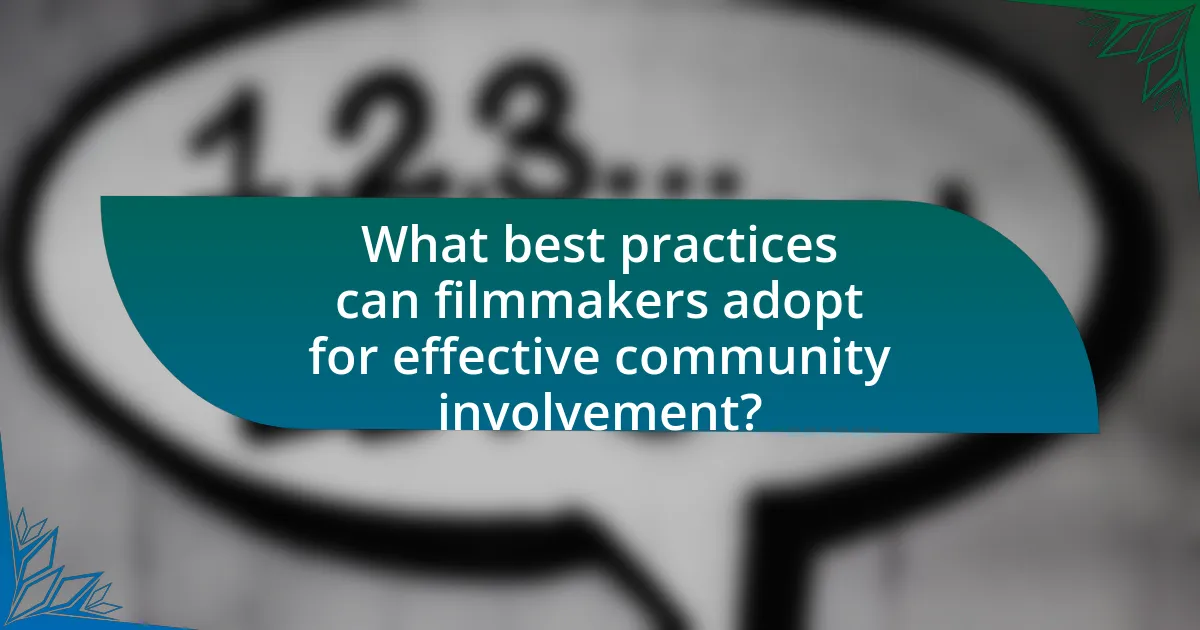The article examines the critical role of community in creative film projects, emphasizing collaboration, resource sharing, and audience engagement. It highlights how community involvement enhances authenticity, enriches storytelling, and fosters local support, as seen in successful films like “The Florida Project” and “The Blair Witch Project.” Key aspects discussed include the influence of community feedback on creative decisions, the benefits of local talent, and strategies for effective community engagement. Additionally, the article addresses challenges filmmakers face when involving communities and offers practical tips for building strong relationships with local stakeholders.

What is the role of community in creative film projects?
The role of community in creative film projects is essential for collaboration, resource sharing, and audience engagement. Communities provide filmmakers with access to diverse talents, skills, and perspectives, which enhance the creative process and lead to richer storytelling. For instance, local film collectives often pool resources, such as equipment and locations, making projects more feasible and cost-effective. Additionally, community involvement fosters a sense of ownership and investment in the project, which can translate to a dedicated audience base. Research indicates that films with strong community ties often achieve greater local support and viewership, as seen in projects like “The Florida Project,” which highlighted local culture and garnered significant community interest.
How does community involvement influence film production?
Community involvement significantly influences film production by enhancing authenticity and fostering local engagement. When filmmakers collaborate with community members, they gain access to genuine stories, cultural nuances, and local talent, which enrich the narrative and visual representation of the film. For instance, films like “The Florida Project” utilized local residents as actors, which not only provided authenticity but also created a sense of ownership among the community. This collaboration can lead to increased support for the film, as local audiences feel represented and invested in the project. Additionally, community involvement can facilitate logistical support, such as locations, resources, and funding, which are crucial for independent filmmakers.
What are the key aspects of community engagement in filmmaking?
Key aspects of community engagement in filmmaking include collaboration, representation, and feedback. Collaboration involves filmmakers working closely with community members to ensure their stories and perspectives are authentically represented. Representation is crucial as it ensures diverse voices and experiences are included, fostering a sense of ownership among community members. Feedback mechanisms allow communities to provide input during the filmmaking process, enhancing the relevance and impact of the final product. Research indicates that films created with community involvement often achieve greater resonance and social impact, as seen in projects like “The Interrupters,” which effectively engaged the Chicago community to address violence.
How does community feedback shape creative decisions?
Community feedback significantly influences creative decisions by providing insights that align projects with audience expectations and preferences. This feedback can guide filmmakers in refining narratives, character development, and visual styles, ensuring that the final product resonates with viewers. For instance, during the production of “The Blair Witch Project,” early screenings and audience reactions led to adjustments in marketing strategies and narrative pacing, ultimately contributing to its success. Such examples illustrate how community input can directly impact creative choices, enhancing the relevance and appeal of film projects.
Why is community collaboration essential for filmmakers?
Community collaboration is essential for filmmakers because it enhances creativity, resource sharing, and audience engagement. Filmmakers benefit from diverse perspectives and skills that community members bring, leading to innovative storytelling and production techniques. For instance, collaborative projects often result in a richer narrative, as seen in community-driven films like “The Blair Witch Project,” which utilized local talent and resources to create a compelling story. Additionally, community collaboration fosters a sense of ownership and investment among local audiences, increasing the likelihood of support and viewership. This synergy not only strengthens the film’s impact but also builds lasting relationships within the community, ultimately contributing to the sustainability of independent filmmaking.
What benefits does collaboration bring to the creative process?
Collaboration enhances the creative process by fostering diverse perspectives and ideas, which leads to more innovative outcomes. When individuals from different backgrounds and skill sets come together, they contribute unique insights that can challenge conventional thinking and inspire new approaches. Research indicates that teams with varied expertise are more likely to produce high-quality creative work, as evidenced by a study published in the Journal of Creative Behavior, which found that collaborative groups generated more original ideas compared to individuals working alone. This synergy not only enriches the creative output but also promotes a sense of shared ownership and motivation among team members, further driving the creative process forward.
How can filmmakers leverage community resources effectively?
Filmmakers can leverage community resources effectively by actively engaging local organizations, businesses, and individuals to support their projects. This collaboration can include securing locations, obtaining equipment, and accessing talent, which can significantly reduce production costs. For instance, a study by the University of Southern California found that films utilizing local community resources often report a 30% decrease in budget overruns. Additionally, filmmakers can foster goodwill and enhance their projects’ authenticity by involving community members in the storytelling process, which can lead to increased audience engagement and support.
What challenges do filmmakers face when involving the community?
Filmmakers face several challenges when involving the community, including communication barriers, differing expectations, and resource limitations. Communication barriers can arise from cultural differences or lack of familiarity with filmmaking processes, which may lead to misunderstandings. Differing expectations between filmmakers and community members can result in conflicts over creative direction or project goals. Additionally, resource limitations, such as funding and time constraints, can hinder the ability to effectively engage the community, as seen in projects that require extensive outreach or collaboration. These challenges can impact the overall success and authenticity of community-involved film projects.
What are common obstacles in community engagement?
Common obstacles in community engagement include lack of trust, insufficient resources, and communication barriers. Lack of trust can stem from previous negative experiences with organizations or projects, leading to skepticism about intentions and outcomes. Insufficient resources, such as funding, time, and personnel, can hinder the ability to effectively engage community members. Communication barriers, including language differences and varying levels of digital literacy, can prevent effective outreach and participation. These obstacles are frequently cited in studies on community engagement, such as the “Community Engagement Framework” by the National Institute for Health Research, which highlights the importance of addressing these issues to foster meaningful participation.
How can filmmakers overcome these challenges?
Filmmakers can overcome challenges by actively engaging with their local communities to build support networks and resources. By collaborating with local organizations, filmmakers can access funding, talent, and venues that may not be available through traditional channels. For instance, community partnerships can provide filmmakers with access to grants specifically aimed at supporting local arts initiatives, which can alleviate financial constraints. Additionally, filmmakers can host workshops and events to foster relationships with community members, creating a collaborative environment that encourages participation and investment in the project. This approach not only enhances the film’s authenticity but also strengthens community ties, as evidenced by successful projects like “The Florida Project,” which utilized local residents as actors and crew, enriching the storytelling experience.
How does community impact the distribution and reception of films?
Community significantly impacts the distribution and reception of films by influencing audience engagement and shaping marketing strategies. Local communities often serve as primary audiences for films, affecting box office performance and word-of-mouth promotion. For instance, films that resonate with community values or address local issues tend to receive stronger support, leading to increased viewership and positive reception. Additionally, community events, such as film festivals, provide platforms for independent filmmakers to showcase their work, enhancing visibility and distribution opportunities. Research indicates that films with strong community ties often achieve higher ratings and audience satisfaction, as seen in the success of regionally focused films like “Moonlight,” which garnered critical acclaim and community support, ultimately winning the Academy Award for Best Picture.
What role does community play in marketing and promoting films?
Community plays a crucial role in marketing and promoting films by fostering engagement and building a loyal audience base. When a film engages its community, it creates a sense of ownership and investment among viewers, which can lead to organic word-of-mouth promotion. For instance, films like “The Blair Witch Project” successfully utilized community engagement through grassroots marketing strategies, generating significant buzz and anticipation prior to release. This approach not only enhances visibility but also encourages community members to share their experiences and recommendations, amplifying the film’s reach.
How does community support affect audience reception?
Community support significantly enhances audience reception by fostering a sense of belonging and shared investment in creative projects. When a community actively engages with a film project, it creates a network of advocates who promote the work, leading to increased visibility and interest. For instance, studies have shown that films with strong community backing often experience higher attendance rates and more positive reviews, as seen in the case of independent films that leverage local support for marketing and outreach. This communal involvement not only amplifies the film’s reach but also cultivates a more favorable perception among audiences, as they feel part of a collective experience.

What types of communities are involved in creative film projects?
Various types of communities are involved in creative film projects, including local filmmakers, film schools, cultural organizations, and online film communities. Local filmmakers often collaborate on projects to share resources and expertise, while film schools provide a platform for students to engage in hands-on experience and networking. Cultural organizations may support film projects that reflect specific cultural narratives or themes, fostering community engagement and representation. Online film communities, such as forums and social media groups, facilitate collaboration and feedback among filmmakers from diverse backgrounds, enhancing the creative process. These communities collectively contribute to the richness and diversity of creative film projects.
How do local communities contribute to film projects?
Local communities contribute to film projects by providing essential resources, locations, and local talent. These contributions enhance the authenticity and cultural relevance of the film, as filmmakers often seek to portray genuine local experiences and settings. For instance, community members may offer their homes or businesses as filming locations, which can reduce production costs and foster local engagement. Additionally, local actors and crew members bring unique insights and skills that enrich the storytelling process. Research indicates that films shot in local communities often achieve greater audience connection and support, as seen in projects like “The Florida Project,” which utilized real local residents to depict the story authentically.
What are the benefits of filming in local settings?
Filming in local settings offers numerous benefits, including cost-effectiveness, authenticity, and community engagement. Local settings reduce travel expenses and logistical challenges, allowing filmmakers to allocate resources more efficiently. Authenticity is enhanced as local landscapes, architecture, and culture contribute to a genuine representation of the story being told. Furthermore, engaging with the local community fosters collaboration, provides access to local talent, and can lead to increased support for the project, as seen in various independent films that successfully utilized local resources and talent, such as “The Florida Project,” which showcased the community of Kissimmee, Florida.
How can local talent enhance film production?
Local talent can enhance film production by providing authentic cultural representation and localized knowledge that enriches storytelling. This authenticity resonates with audiences, as seen in films like “Moonlight,” which garnered critical acclaim for its genuine portrayal of the African American experience in Miami. Furthermore, local talent often possesses unique insights into regional settings, customs, and dialects, which can lead to more relatable and immersive narratives. Studies indicate that films featuring local actors and crew can achieve higher viewer engagement and box office success, demonstrating the tangible benefits of incorporating local talent into film projects.
What role do online communities play in filmmaking?
Online communities play a crucial role in filmmaking by providing platforms for collaboration, feedback, and resource sharing among filmmakers. These communities facilitate networking opportunities, allowing filmmakers to connect with peers, industry professionals, and audiences, which can lead to partnerships and funding opportunities. For instance, platforms like Reddit and Facebook groups enable filmmakers to share their work, receive constructive criticism, and gain insights from diverse perspectives, enhancing the quality of their projects. Additionally, online communities often serve as a space for crowdfunding, where filmmakers can raise funds directly from supporters, exemplifying the power of collective engagement in the creative process.
How do social media platforms facilitate community engagement?
Social media platforms facilitate community engagement by providing interactive spaces where users can share content, communicate, and collaborate. These platforms enable users to form groups, participate in discussions, and share experiences related to specific interests, such as creative film projects. For instance, Facebook groups and Twitter hashtags allow filmmakers and audiences to connect, share feedback, and promote projects, fostering a sense of belonging and collaboration. Research indicates that 72% of adults use social media, highlighting its role in connecting communities and enhancing engagement through shared interests and real-time interactions.
What are the advantages of virtual collaboration in film projects?
Virtual collaboration in film projects offers significant advantages, including increased accessibility to diverse talent and cost efficiency. By utilizing online platforms, filmmakers can connect with professionals from various geographical locations, enhancing creativity and bringing unique perspectives to the project. Additionally, virtual collaboration reduces overhead costs associated with travel and physical studio spaces, allowing for more budget allocation towards production quality. Studies show that remote teams can be just as productive as in-person teams, with tools like video conferencing and project management software facilitating effective communication and workflow management.

What best practices can filmmakers adopt for effective community involvement?
Filmmakers can adopt several best practices for effective community involvement, including engaging local stakeholders early in the project, fostering open communication, and incorporating community feedback into the filmmaking process. Engaging local stakeholders, such as community leaders and organizations, ensures that the film reflects the community’s values and needs, which can enhance authenticity and support. Open communication allows filmmakers to build trust and rapport, making community members feel valued and invested in the project. Incorporating community feedback not only improves the film’s relevance but also encourages community ownership, leading to greater support and participation. Research indicates that projects involving community input often result in higher audience engagement and satisfaction, demonstrating the importance of these practices in successful filmmaking.
How can filmmakers build strong relationships with their communities?
Filmmakers can build strong relationships with their communities by actively engaging with local residents and organizations throughout the filmmaking process. This engagement can include hosting community screenings, conducting workshops, and collaborating with local artists and businesses to create projects that reflect the community’s culture and values. For instance, a study by the University of Southern California found that films that incorporate local narratives and involve community members in production foster a sense of ownership and pride, leading to stronger community ties. By prioritizing transparency and open communication, filmmakers can ensure that their projects resonate with the community, ultimately enhancing support and participation.
What strategies can be used to foster community trust and support?
To foster community trust and support, engaging in transparent communication is essential. This involves consistently sharing project updates, addressing community concerns, and actively soliciting feedback. Research indicates that transparency in community projects leads to increased trust; for instance, a study by the Stanford Social Innovation Review found that organizations that prioritize open communication see a 30% increase in community engagement. Additionally, building partnerships with local organizations can enhance credibility and demonstrate commitment to the community’s interests, further solidifying trust.
How can filmmakers ensure inclusive participation from diverse community members?
Filmmakers can ensure inclusive participation from diverse community members by actively engaging with various groups throughout the filmmaking process. This includes conducting outreach initiatives to identify and involve underrepresented voices, facilitating workshops that encourage community input, and creating advisory boards composed of community representatives. Research indicates that projects with community involvement not only enhance representation but also improve the authenticity of the narrative, as seen in the success of films like “Black Panther,” which featured a predominantly Black cast and crew, reflecting the cultural richness of its source material.
What are some successful examples of community-driven film projects?
Successful examples of community-driven film projects include “The Blair Witch Project,” which was produced on a budget of $60,000 and grossed nearly $250 million worldwide, showcasing the power of grassroots marketing and community engagement. Another notable example is “Tangerine,” filmed entirely on an iPhone and funded through Kickstarter, which raised over $100,000, highlighting the impact of community support in independent filmmaking. Additionally, “The Florida Project” received acclaim for its authentic portrayal of community life, with local residents involved in the production, emphasizing the collaborative nature of community-driven projects. These films demonstrate how community involvement can lead to both critical and commercial success.
What lessons can be learned from these case studies?
The lessons learned from these case studies highlight the importance of community engagement in creative film projects. Successful projects demonstrate that involving local communities fosters collaboration, enhances storytelling authenticity, and increases audience investment. For instance, case studies reveal that films co-created with community input often resonate more deeply with viewers, as seen in projects like “The Florida Project,” which utilized local residents’ experiences to shape its narrative. This approach not only enriches the film’s content but also builds a supportive network that can aid in marketing and distribution, ultimately leading to greater success.
How did community involvement enhance the success of these projects?
Community involvement significantly enhanced the success of creative film projects by fostering collaboration, increasing audience engagement, and securing local support. When community members actively participated in the filmmaking process, they contributed diverse perspectives and skills, which enriched the storytelling and production quality. For instance, projects that included local talent and resources often saw higher levels of authenticity and relatability, leading to greater audience connection. Additionally, community involvement often resulted in increased funding and resources, as local stakeholders were more likely to support initiatives they felt personally invested in. This collaborative approach not only improved the overall quality of the films but also ensured a more robust distribution network, as community members became advocates for the projects, promoting them within their networks.
What practical tips can filmmakers use to engage their communities effectively?
Filmmakers can engage their communities effectively by hosting local screenings and discussions that invite audience participation. This approach fosters a sense of ownership and connection to the film, as evidenced by the success of community-driven projects like “The Blair Witch Project,” which utilized grassroots marketing and local events to build a dedicated following. Additionally, collaborating with local artists and organizations can enhance community ties, as seen in initiatives like the “Community Cinema” program, which brings films to underserved areas and encourages dialogue. By actively involving community members in the filmmaking process, such as through workshops or volunteer opportunities, filmmakers can create a more inclusive environment that resonates with local audiences.


